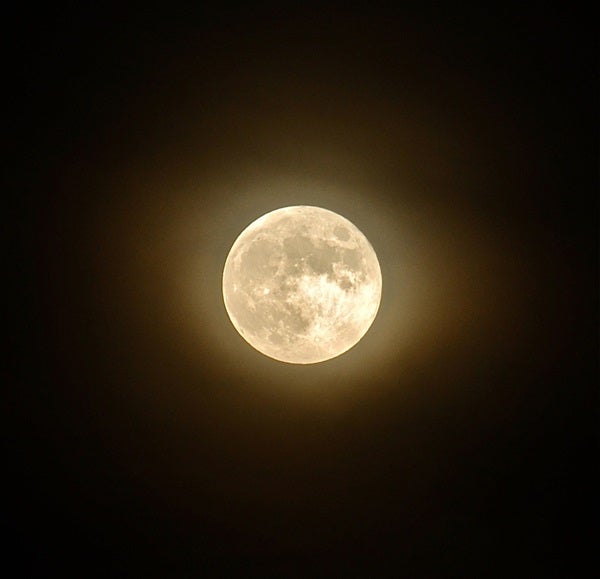Maybe we should look at this phenomenon. After all, astronomers would love to see a wider interest in the night sky. But the dichotomy between “us” and “them” can’t be ignored. It shows itself on public viewing nights when half the visitors ask, “What power is your telescope?” and we wearily explain that the power changes whenever we switch eyepieces — and that low power often gives a better view than high. They’re then baffled that we never point telescopes at the Full Moon.
Thirty years ago, when I took over as astronomy editor of the Old Farmer’s Almanac, the first thing I did was discontinue all mention of penumbral eclipses, minor meteor showers, and all such non-events that were likely to disappoint the public. The recent Super Moon craze falls firmly in that category. The label suggests an amazing event, but it’s a visual letdown. Astronomy doesn’t need that.
So now rewind to January when countless media sources were urging people, “Go out and look at the big Super Moon!” Those who did were disappointed because a perigean Full Moon is never more than 7 percent larger than the average Full Moon, which isn’t enough for the eye to detect. Nothing was different.
What’s really going on, I think, is that the public has a long-standing, deep-rooted Moon fascination. The public also likes to name things, which is reflected in the media’s quick embrace of those newly coined Full Moon labels. A Depression-era magazine error created the term Blue Moon as we use it today, while Super Moon and Blood Moon were coined only a few years ago. Not any are used by astronomers. Should we now suddenly make them part of our vocabulary?
But when these labels came together January 31, and the media figured out that it’s been 152 years since the second Full Moon in the same month underwent a total eclipse while it was also at perigee — wow, it sure sounded like an amazing rare event that shouldn’t be missed. No one was in the mood to say, “Bah, humbug.” And thus few in the media bothered mentioning that such a low eclipse might easily be hidden by hills or houses, or that dawn would arrive before totality for the Eastern U.S. and Canada, so no “blood” would even flow.
Thus, intense media attention surrounded a sky “event” that most astronomers didn’t even bother setting an alarm for. When it was over, the gulf between the public and those who love astronomy remained as wide as always. But I’ll bet the high-up midnight lunar totality on January 21, 2019, visible throughout the U.S., will get us all out, no questions asked. And sure, let them call it another Blood Moon. What’s the harm?
In the meantime, let’s test this idea that the public adores new names for Full Moons.
Many get this magazine late in the month, in time for the June 28 Full Moon. This happens to be the lowest Full Moon of the year, which somehow does not have an official name. So let’s give it one. What if we now decide to call the Full Moon closest to the summer solstice the “Honey Moon”?
Since this lowest of all Full Moons must shine through the thicker air near the horizon, plus the warm season’s atmosphere typically contains more moisture, it will likely look more amber colored than most Full Moons, making “Honey Moon” a perfect label. Let’s start using that term annually, and you know what? I’ll bet five years from now, “Honey Moon” will be repeated by the media as the official title of the June Full Moon. If it works, we’ll know that we were all in on the experiment.











